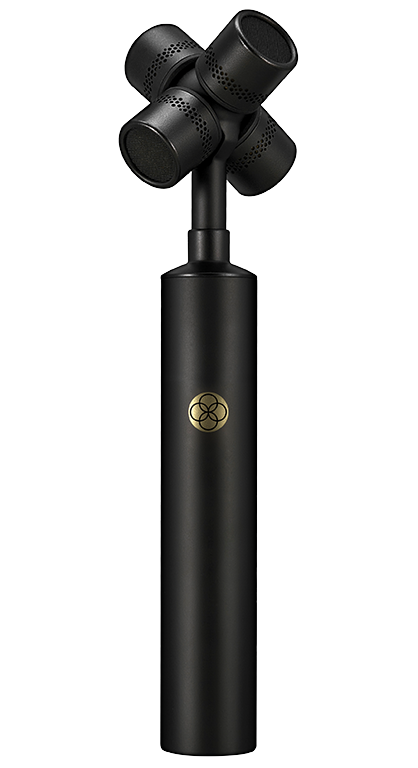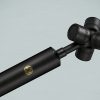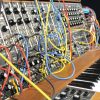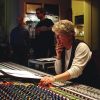
Review: RØDE NT-SF1
Rode hasn’t just made professional ambisonics affordable, it’s delivered a mic that can take ambisonics beyond its usual ‘ambiences-only’ call.
These days I’m opening more VR headsets and gaming console packaging than microphones. Sleek and shiny boxes are par for the course when trying to catch the eye of the would-be consumer; less packing foam and more ‘presentation display’. With one eye squarely on the gaming audio market, it’s fitting that Rode’s NT-SF1 ambisonics microphone arrives nestled in a similarly attractive sleek black box.
While I’m always tempted to retain the pretty box, the reality is it will spend its life in a more durable road case, and the build quality of Rode’s microphone looks like it will be up to the recordist’s schlep.
BOX OF GOODIES
An ambisonic microphone has a fairly specific range of uses. Primary among those is capturing location ambiences, so mounting and wind protection are not optional extras in my mind.
In the box is everything you’ll need to use the NT-SF1 in practical situations. Better yet, they’re not generic attachments; Rode has designed each component specifically for the NT-SF1. Instead of the usual hard plastic mic clip, Rode has included a tight-fitting rubberised shock mount for the NT-SF1. This attaches to any standard boom pole or mic stand screw thread. Wedging the microphone into the clip is a little tricky, so you won’t be doing it in a hurry. When working with ambisonics, you shouldn’t be doing anything in a hurry anyway. Rode has also included a spherical windshield and fluffy wind sock system to work with the shock mount clip. I’ll get to how it holds up in various environmental conditions, but for now, I rate the inclusion of these components very highly.
NOT JUST A CABLE
For those unfamiliar with ambisonic microphones, the mic itself contains four capsules. Each capsule’s signal is captured separately so you can create different polar patterns in post production. Naturally, a custom cat-tail cable is required to turn one output plug into four standard XLR jacks. Some ambisonic microphones I’ve used have shipped with a cable that’s too short to be of much use. The Rode NT-SF1 cable is split over a length of three meters, making it convenient for most common purposes.
A second feature of the cable is that each of the four XLR jacks are clearly colour-coded and labelled with LF1 for ‘Left Front 1’, and so on. It makes my life in the field so much easier — consider this my ‘Thank You’ note to the blessed boffin at Rode who decided to add it. Anything that can improve my experience working with a piece of equipment shows an understanding by the manufacturer of what I do. In turn, making me feel comfortable and confident to work with that equipment. It’s also simply a really well-made cable.
LOW END DETAIL
When I first rigged up the mic into my Sound Devices 788T SSD and had a listen, I was surprised by how much low-end the microphone picked up. I wouldn’t have been if I’d read the specs, which clearly show the condenser capsules are well capable of a wide frequency range. Still, I’ve become familiar with the idea of ambisonics only being used for capturing ambiences, so in my mind I was expecting a much lighter tone. The low-end sensitivity makes this mic very well suited to recording musical performances and this, in my mind, is an excellent use of ambisonic technology. Sadly, I didn’t have an ensemble hanging around to test it on, but from the sounds I was able to capture and a little bit of abstraction I imagine it would have a lovely warm tone at the low end for instruments.
NEED TO KNOW
Rode NT-SF1
Ambisonics Microphone

The primary purpose of ambisonic equipment is to capture that spherical sound-field, so I jumped right into testing its detail early on. I used a ratchet noise maker to create a constant clicking sound and then moved it around the NT-SF1 on a flat plane at first, then over and under the mic to test the elevation region. I chose the ratchet because humans can localise repeated pulses far more accurately than a constant ‘noise’ source. Human ears are pretty terrible at working out accurately where a sound is coming from, making it tricky to evaluate how accurately a sound sphere is represented, but there are some significant factors I found with this mic.
In the obvious zones on the left and right past our ears the sound field was clear and strong. What was important was the elevation movement above and below the horizon plane. I had a very clear sense of movement and differentiation as I turned my head with a VR headset on while listening to the recordings. This is an indication that the NT-SF1 is capturing good delineation between its capsules. Effective sound field content is as much about what you record as what equipment you use, but the NT-SF1 has nice separation and creates a good sense of space. I did notice a slight pop when I moved the ratchet too close to one of the capsules, so they are sensitive to close-proximity, but this is unlikely to be an issue for 90% of the uses for an ambisonic mic. Ambisonics is not generally effective for near-field content anyway, so a sound source within one meter is not a common recording target and the sensitivity is otherwise a desirable quality.
ONLY THE GOOD NOISE
The level of self-noise for a microphone such as this can be critical. Capturing ambiences is one of the primary uses of an ambisonic microphone and often that is going to be in very quiet locations. Capturing birds, gentle wind or even room tones are the sorts of things I would purchase an ambisonic mic for. I use an old wind-up clock for this kind of testing. The Sound Devices 788 I own has its own noise issues at certain gain levels, but I have been using it long enough to know exactly where those kick in and what to expect. Over 50dB input gain starts to get noticeably noisy with the 788, so anything under that is most likely the mic.
The NT-SF1 is certainly very sensitive. It clearly captured the ticking clock with good definition and even picked up my stomach rumbling. That’s what I get for doing tests just before lunchtime! As far as additional noise goes the NT-SF1 added no noticeable noise to the recordings. In fact, dialling up the input gain to even 60dB on the 788 had far less hiss than many of the mics I use regularly. I am impressed that Rode seems to place the same level of importance on low self-noise as I do for a mic such as this. As a bit of extra due diligence, I reached out to a few other recordists I know around the world to check their experience. I am aware that with some products you can get a bit of variation in self-noise. However, all the comments I got back on the NT-SF1 confirmed this mic is very good in that regard, which says a lot about Rode’s automated manufacturing facility.
WINDSHIELD WIPES OUT WIND
I have been a location recordist for nearly 20 years and apart from noisy humans, wind is the biggest issue I deal with, so of course I wanted to check out how the NT-SF1 copes with wind. Conveniently there is also a lookout tower about five minutes from where I live. Located above the forest canopy, it’s the perfect place to subject microphones to some serious gusts of wind. Initially, I removed both the provided fluffy and the top hemisphere of the windshield to expose the microphone directly to the wind.
As expected, the NT-SF1 diaphragms did not enjoy direct exposure to fairly strong gusts of wind, what was not expected was that the windshield alone cut the wind noise to almost zero. Only the very strongest of wind gusts translated as noise through the windshield. This surprised me as although I know the shield does reduce wind, I often consider them more just the structure that allows the fluffy to be mounted. In this example the addition of the fluffy cover allowed me to record the ambience and the strong wind itself without distortion. The advantage of a microphone that captures a sphere is it can have any orientation. If the wind were strong enough to disrupt one of the diaphragms, as an ambisonic mic, it could be rotated slightly to angle the wind away from a direct path to the diaphragm.

MORE THAN JUST AMBIENCES
Ambisonics is a tricky animal for recording. Up till now there have been two main choices. Either spend a fortune on a high-end ambisonic solution, or buy one of the low-end microphones available and deal with their shortcomings.
We have long needed something in the mid-range that supports quality sound field capture but didn’t require a second mortgage to purchase. Rode appears to have gone one better by providing a really solid tool, that is barely more expensive than the bottom range options.
This is a solid and capable microphone. The biggest surprise has been the way it’s changed my view of ambisonics. Previously, I’d considered ambisonics to be a specific narrow task; a useful piece of equipment to have on the occasion I need to capture a spherical field. After working with the NT-SF1, I realised I could use this mic for a far broader range of uses. Because ambisonic content can be down-mixed to stereo, mono or the various surround formats without any loss of content, I could see this microphone system replacing quite a few of my omni-directional and stereo microphones for collecting ambiences or recording music. Why capture a stereo image when you can capture a spherical sound-field for almost no extra effort?
What really tips it for me is the inclusion of all the necessary extra pieces. Rode could have offered these pieces as additional optional extras, but it knows that a shock-mount and wind protection are not in the least bit optional. I applaud Rode for including them as part of the purchase price.
Straight out of the box, you get not just an ambisonic microphone, but an ambisonic recording system.

Stephan Schütze has been a location recordist and sound designer for nearly 20 years. His sound libraries are used by many of the top production companies in the world and in 2018 he released the first book on audio production for new reality formats.


























I’ve been interested in this mic for a VERY long time. I’m a composer and audio engineer so something I do for a little extra cash is recording for my friends. I want to dwell into the world of orchestral recording and subsequently am considering investing in a Decca tree style system but this review may honestly change my mind! It’ll save me a fair bit of cash too, do you think it could replace a Decca tree or do you think it would be a good mic to just add to the mix?
Really enjoyed the article! I recently got this microphone and so far I’m really enjoying it! I was just thinking this week, why do I need now a stereo setup for recording ambiences when I can just record with this mic and output in Stereo right?
“Human ears have difficulty locating sound” from sources which are continuous tones or random/pseudo random noise. You are correct that transients are the best directional cues. We also have difficulty locating sound from conventional monitors, headphones, home and stage speakers because if the speakers were easy to locate, pan-pot fake stereo images collapse. Therefore 99% of speaker designs are evolved to be locationally vague with spatial masking techniques like sharp-edged baffles and grill frames.
Further, directional hearing of musical sounds is inhibited by learning to hear music through speakers, and listening to speakers and/or headphones for a living like audio engineers.
Conservatory trained musicians grow 10 billion more neurons from daily practice, partly to hear time and space ten times better than the general population. When I heard a demonstration at the US premiere of Ambisonics in 1978, it was a revelation. I was sure it would catch on, but the developmental hearing impairment caused by audio and other noise pollution has slowed it 40 years!
Thank you for a thoughtful and intelligent review. I was surprised to learn of noise issues on your Sound Devices recorder as this was a machine I was considering. For now I have purchased a Tascam DR-680MKII 8-Track Field Recorder sbut secondhand. I am still looking but you make a very good case for the NT-SF1. Thank you again and live long & pprosper,
Gordon Foley.
PS: I will take a listen to your sound library if I can find it.